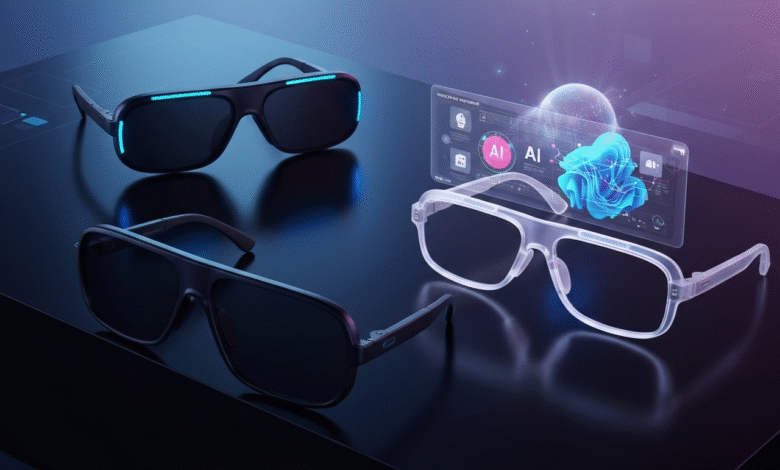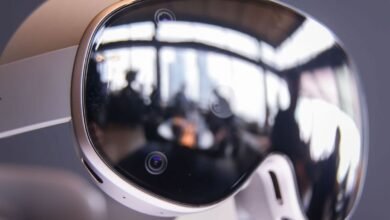Apple Ditches Budget Vision Pro for Meta-Rivaling Smart Glasses

▼ Summary
– Apple is reportedly shelving development of a cheaper, lighter Vision Pro follow-up (codenamed ‘N100’) to focus on smart glasses.
– A hardware refresh of the Vision Pro with an M5 chip is expected soon, maintaining its current weight and high price point.
– Apple is developing two types of smart glasses: audio-only models (codenamed ‘N50’) for 2026/2027 and display-equipped versions accelerated for earlier release.
– The company’s shift to smart glasses aims to compete with Meta’s offerings and represents a strategic move in the race for AI and augmented reality dominance.
– Smart glasses provide crucial user data for AI development and help address component cost challenges through economies of scale.
Apple appears to be shifting its strategic focus away from a more affordable version of its Vision Pro headset, instead accelerating development of smart glasses designed to compete directly with Meta’s offerings. According to a recent Bloomberg report citing insider information, the tech giant has paused work on a lighter, lower-cost headset, often unofficially called the ‘Vision Air’, to channel resources into creating two distinct types of smart glasses. This move signals Apple’s intent to challenge Meta’s growing lineup of Ray-Ban smart glasses and the newly launched Ray-Ban Display models.
Previously, industry watchers anticipated Apple would introduce a consumer-friendly Vision Pro successor. Analyst Ming-Chi Kuo suggested this model, codenamed ‘N100,’ could be over 40% lighter and more than 50% cheaper than the current Vision Pro, potentially weighing under 400 grams and priced below $1,750. Meanwhile, a hardware update for the existing Vision Pro featuring the new M5 chip is reportedly imminent, based on recent regulatory filings. This refreshed model is expected to retain its 600-gram weight and $3,500 price point, however.
Insider sources now indicate the budget-friendly Vision Air project is on hold. In its place, Apple is prioritizing the development of smart glasses. The first model, codenamed ‘N50,’ is an audio-only pair intended to sync with the iPhone and rival Meta’s $300+ smart glasses created with EssilorLuxottica. A preview of these could arrive as early as 2026, with a full release targeted for 2027.
A second model under development will incorporate a display, similar to Meta’s $800 Ray-Ban Display glasses that launched recently in the United States. Originally slated for a 2028 debut, Apple is reportedly fast-tracking this version. Both Apple smart glasses are said to focus heavily on voice interaction and AI integration, offer multiple style options, and run on a new custom chipset.
This accelerated timeline represents a departure from Apple’s traditional strategy. The company usually enters a product category only after the underlying technology has matured, as seen with smartphones, smartwatches, and computers. Its success in these areas stems from a powerful ecosystem and strong brand appeal. The emergence of Meta’s display-equipped smart glasses, however, marks a critical juncture in the competition to define the next major computing platform. While not the final form, display glasses are a significant step toward the ultimate goal of all-day augmented reality wearables, where a robust AI foundation is essential.
Many have adopted a “wait and see” approach with Apple and emerging technologies, especially in virtual reality. The expectation was that Apple would eventually enter the market and redefine it for mainstream audiences with a superior first-generation product. The Vision Pro, however, has not been that transformative device. Even a lighter and cheaper model would struggle against Meta’s offerings, which are priced five to ten times lower.
Artificial intelligence is one area where Apple cannot afford to fall behind, particularly from the perspective of user data collection. Compared to rivals like Google, Microsoft, and OpenAI, Apple has been slower in AI development, only introducing its Apple Intelligence platform in late 2024. The company is expected to launch a rebuilt Siri this year to enhance its hardware ecosystem.
Smart glasses represent the frontline in the AI battleground. As always-on wearable devices, they can gather a wealth of data on user behavior and preferences. This information is invaluable for refining services, understanding what resonates with consumers, and ultimately building the next-generation platform that tech firms are eagerly pursuing: all-day AR glasses.
The true contest extends beyond just competing in a new computing paradigm. Apple also needs smart glasses to help bridge a substantial component price gap. Achieving economies of scale will be crucial for driving down the cost of complex parts, such as the expensive silicon carbide waveguides used in advanced AR prototypes. Furthermore, companies must engineer components compact enough to fit into a standard glasses frame, making smart glasses a vital testing ground for the future of augmented reality.
(Source: Road to VR)


